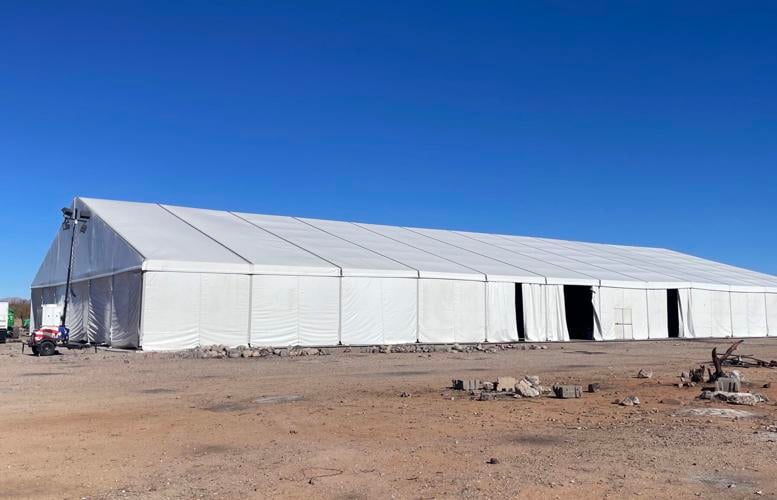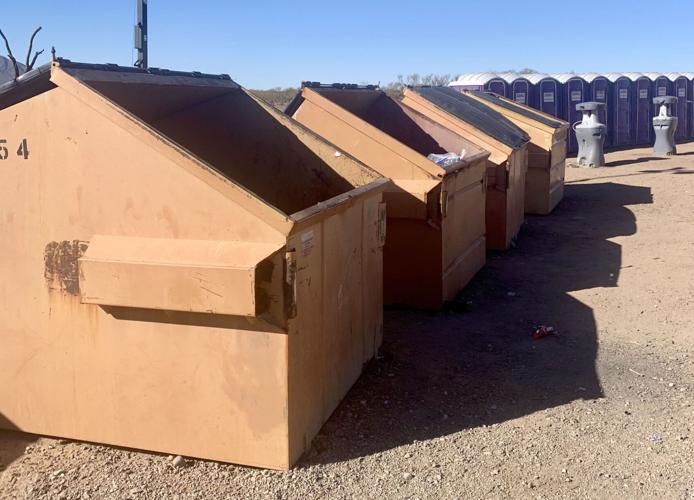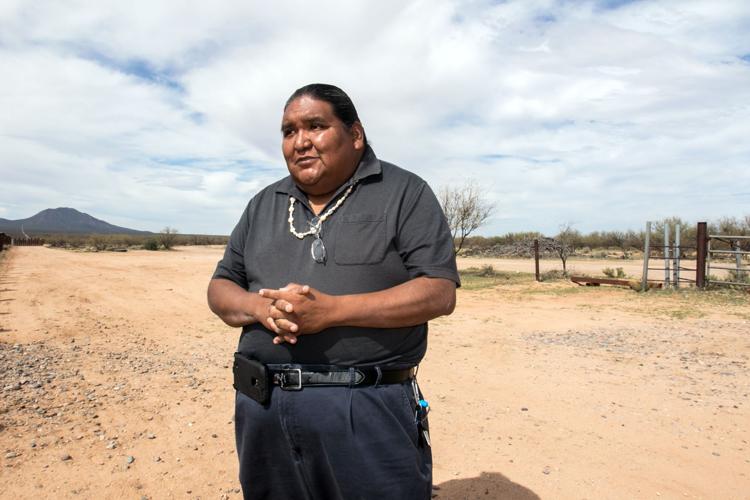While migration to the southern border has slowed in recent weeks, hundreds of asylum seekers continue to arrive daily at the Tohono O’odham Nation’s traditional crossing, known as the San Miguel Gate, tribal leaders said this week.
Humanitarian volunteers say asylum seekers also continue to cross into Arizona about 15 miles east of Sásabe, Arizona, in a remote, tough-to-access location without bathroom facilities or shelters other than what volunteers have built in recent weeks.
Over the weekend, about 1,000 asylum seekers arrived in Arizona through the San Miguel Gate, a pedestrian border crossing for Tohono O’odham Nation members visiting ancestral lands in Mexico, said Tohono O’odham Chairman Verlon Jose on Tuesday night.
The majority of arrivals at San Miguel Gate are members of family units, including young children, he said. Between 300 and 500 continue to arrive each day, a significant drop from the more than 1,000 daily arrivals seen in December, but still a massive burden on tribal lands, he said.
“The Tohono O’odham Nation has continuously stated that it’s a federal responsibility to address this issue,” Jose said.
In response to pressure from the Tohono O’odham Nation to address the environmental damage and humanitarian concerns resulting from the surge at San Miguel, U.S. Customs and Border Protection has installed a large, heated white tent, with the capacity to shelter up to 1,000 asylum seekers as they wait to be transported for processing, Jose said.
Before this infrastructure was added, migrants desperate for warmth in freezing temperatures were using native trees as firewood, Jose said.
CBP has also set up portable toilets and hand-washing stations near the San Miguel Gate. The Tohono O’odham Nation brought in four garbage bins to collect trash and personal items left behind as migrants are taken in for processing, Jose said.

The Tohono O'odham Nation brought four garbage bins near the San Miguel Gate on the U.S.-Mexico border, where hundreds of migrants continue to cross daily, tribal chairman Verlon Jose said Tuesday. The surge in arrivals on tribal lands has led to an environmental disaster, as well as humanitarian concerns for vulnerable asylum seekers waiting in harsh conditions for transport to Border Patrol processing stations, aid workers say.
Tohono O’odham police are still catching some migrants who are attempting to evade detection, but the vast majority of arrivals through San Miguel are asylum seekers who want to surrender to authorities. Once in Arizona, the migrants are not venturing further into the nearby tribal villages, Jose said.
“They’re coming across the border and they’re just sitting down and waiting to be apprehended,” he said. “The majority of these folks will tell you that they’re coming because they’re either fleeing war-torn countries or violence in their communities.”
Migrant arrivals at the southern border have slowed significantly in recent weeks, in part due to the holidays but also likely due to stepped-up enforcement in Mexico. The slow-down follows a Dec. 27 meeting between top Biden administration officials and Mexican President Andrés Manuel López Obrador, focused on Mexico’s role in slowing migration to the U.S. border.
During the week that ended Jan. 12, Tucson sector border agents apprehended 9,200 migrants, compared to 19,400 in the week that ended Dec. 22, according Tucson Sector Border Chief John Modlin’s posts on X, formerly Twitter.
Volunteers: Humanitarian work crucial in cold
Human smugglers in Mexico continue to leave asylum seekers at a remote area of the border wall, south of Arivaca, Arizona, and about 15 miles east of the Sásabe, Arizona port of entry, volunteers with humanitarian aid groups say.
The Tucson and Green Valley Samaritans have long visited this area, especially since the surge in migrant arrivals here began last fall. Since December, the Samaritans have been coordinating with the group No More Deaths to ensure a humanitarian presence in the region every day.
Freezing temperatures and heavy rain have brought life-threatening cold to migrants who would be completely unsheltered without those humanitarian efforts, volunteers say. The Border Patrol didn’t routinely patrol this area before aid workers began reporting the presence of large groups of migrants there.
Aid workers here have helped children as young as 3 months old, and elderly travelers in their 80s, said Tucson Samaritan volunteer Charles Cameron. Humanitarian efforts — including transporting asylum seekers with medical emergencies to Sásabe — have undoubtedly saved lives, he said.
Volunteers have also dug latrines to address a growing sanitation crisis in the area, Cameron said.
“I was out there a few weeks ago shoveling human excrement into those trenches that were dug,” he said. “It’s just appalling, the state of sanitation out there. It’s not acceptable anywhere, particularly in the United States of America.”
Volunteers are providing food, water, shelter and medical assistance to asylum seekers, but the Border Patrol has threatened to arrest volunteers for transporting asylum seekers experiencing medical emergencies, including seizures and heart problems, said No More Deaths volunteer Aryanna Tischler.
Tischler said volunteers will call 911 to report a medical emergency at the wall and get transferred to the Border Patrol. But often agents don’t show up, even in response to “dire medical emergencies,” she said.
“That leaves us with no other option. We’re not going to let people die in the desert,” she said. “They’ll say they don’t have the resources, while they’re one of the most well-funded federal agencies. All the while, none of us are paid. We’re all volunteers.”
CBP says agents continue to prioritize the transportation of vulnerable populations.
“CBP has taken significant steps to surge personnel and resources to impacted sectors and address the challenges we are experiencing across the southwest border,” a CBP spokesman said in a statement.
No More Deaths has built out a make-shift encampment in this area east of Sásabe, to provide “basic harm reduction” with tents for warmth and a rugged cooking area to provide warm food to asylum seekers, Tischler said.
The volunteers had attached tarps to the border wall to create additional shelters from the cold, but CBP taped “cease-and-desist” letters to the structures.
CBP says the shelters against the border fence created a safety hazard and interfered with the operations of law enforcement and construction crews, who need access to the border road, according to the agency. The tents also obstructed visibility across the border, where cartel violence has been increasing in close proximity to the border wall.
Volunteers removed all the tents within the “Roosevelt Reservation” — the 60 feet of land on either side of the international border that is owned by CBP — but the encampment remains on the national forest land, across the road from the wall, Tischler said.
More remote crossings
Migrant arrivals increased in this area after the Biden administration closed several gaps in the border wall that were closer to the Sásabe port of entry, where smugglers had previously been dropping migrants.
Violence in Sásabe, Sonora — and related conflicts between criminal groups vying for control of smuggling routes in the region — has also contributed to smugglers dropping off migrants in new locations, including further east of Sásabe and just west of the Lukeville port of entry.
Experts say criminal organizations now fully control migration routes south of Arizona’s border with Mexico, making it virtually impossible for migrants to travel to the U.S. border independently.
On Tuesday, Cameron said he arrived east of Sásabe to the make-shift encampment around 8 a.m. and saw a large group of Border Patrol vehicles transporting at least 100 migrants who had likely been there overnight.
Border agents seem to be arriving more regularly there in recent days, Cameron said, perhaps due to fewer migrant arrivals in the Tucson sector freeing up more resources.
The location is a logistical challenge for the Border Patrol, as it is only accessible via an extremely steep gravel road along the border wall that some Border Patrol transport vehicles can’t climb, he said. But recent road work appears to have improved access for Border Patrol vans that had struggled to climb the hills before.
Tischler said federal agencies have created “an invisible crisis in the middle of the desert” by failing to offer more accessible ways for migrants to request asylum and by blocking off gaps in the border wall that allowed entry closer to the Sásabe port of entry and other CBP infrastructure.
“Further wall construction has pushed people out into more remote parts of the desert and has made the situation more deadly,” she said.
Even as border agents threaten humanitarian volunteers with arrest, they appear to be relying on their life-saving work, Tischler said.
“It’s solely their responsibility to be doing almost everything that we’re currently doing,” she said.
Tohono O’odham Chairman Jose said he wants to keep attention on the fact that chaos at the border will continue without comprehensive immigration reform addressing the root causes of migration.
“The border issues don’t begin right here at the U.S.-Mexico border. The border issues start in other countries,” he said. “This is a world issue we’re dealing with. We need to look at how we’re going to address that with our world partners.”
Get your morning recap of today's local news and read the full stories here: tucne.ws/morning






